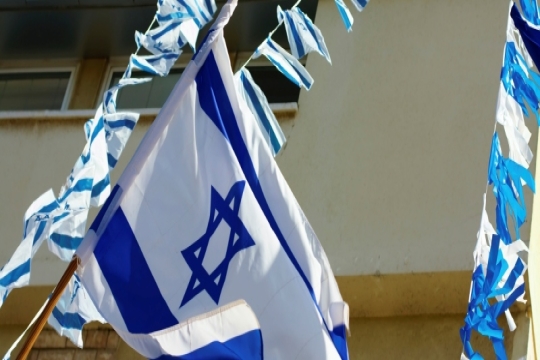
As Marla described in her blog yesterday, the first day of the annual Conference of Presidents of Major American Jewish Organizations was full of hearing from scholars, politicians, government officials, and other Israeli advocates. The second day was a day focused on the strategic defense of Israel.
We began our second day today with an early morning 2 ½ hour bus ride from our hotel in Jerusalem to the major defensive outpost at Andartat ha-Bikaa, which oversees the defense of the Jordan Valley. The drive gave us a magnificent view of the contrasts of this part of Northern Israel. Heading north on Road 90, we saw the verdant fields of citrus groves, olive trees, and miles and miles of crops, some covered to protect them, others braving the harsh climate of the area. On the opposite side of the road, we often saw arid land, full of rocks and looking completely inhospitable to anything green. Then, suddenly, we would see a massive date palm farm – with sections full of mature trees, a section filled with the tiniest of fronds, and every size in between. We saw miles and miles of tubing for drip irrigation – one of the most valuable contributions Israeli innovation has made to global agriculture.
We arrived at the outpost and were given a thorough briefing on the threats this region faces. This defensive area is along the Israeli border with Jordan, with whom this commander has good relations. He meets frequently with representatives of the Palestinian Authority, the Jordanian military, and representatives of the villages – Arab, Israeli, and others.
From here, we drove along the Sea of Galilee, through Tiberias, past Sefad, to the Adir Winery for a delicious lunch, including many goat milk products.
Continuing north towards Lebanon, we finally arrived at an outpost which is under the command of a female officer – one of the first to command such a large group of soldiers. The place we visited was certainly one of the most unusual in all of Israel – a tunnel that was dug by Hezbollah from Lebanon, into this area of northern Israel. Specifically, from the town of Ramya, Lebanon to just a few kilometers from the Israeli villages of Zar’it and Shula. Amazingly, the tunnel is almost a mile long, and is over 260 feet deep! The entrance (on the Israeli side) is over 26 feet below ground. The tunnel has electricity, level steps, a spiral staircase design to allow for the depth, an air circulation system, and a communication system! The entrance in Ramya is underneath a cement factory.
Once its existence was known to the Israelis, a strategic decision was made regarding when to shut it down to ensure that no attacks were staged. In fact, there were a total of six tunnels found. When the Israeli military decided to destroy the tunnel, they pumped concrete into it, beginning at the Blue Line (Lebanese border), and waited for the concrete to “surface” – proving that the tunnel did, in fact, connect Ramya, Lebanon, to this spot in northern Israel.
Once the Israeli entrance was secured, a mezuzah was mounted on the doorframe. Of course! The tunnel is very muddy, and the walls are pocked with impressions from the metal can drill that was used to carve the tunnel. The ground in this area is solid rock, and the best guess is that it took over four years to construct this tunnel.
Following lectures by several of the other military personnel, we got back on the bus and headed to the headquarters of the Galilee Unit. This Israel Defense Forces (IDF) outpost monitors much of the Lebanon border, and they are on constant alert for activity by Lebanon Hezbollah.
After another lengthy bus ride, we arrived in Tel Aviv, at Beit Hatfutsot – the Museum of the Jewish People. This museum houses exhibits that tell the story of the Jewish people. We heard about a new addition that will open in October 2020.
Our long day ended with a 75-minute bus ride back to our hotel in Jerusalem. We were tired, muddied, but filled with confidence in the incredible professionalism and commitment of the IDF.
Related Posts

Continuing to Educate and Empower People Together

My Challah-Making Experience

